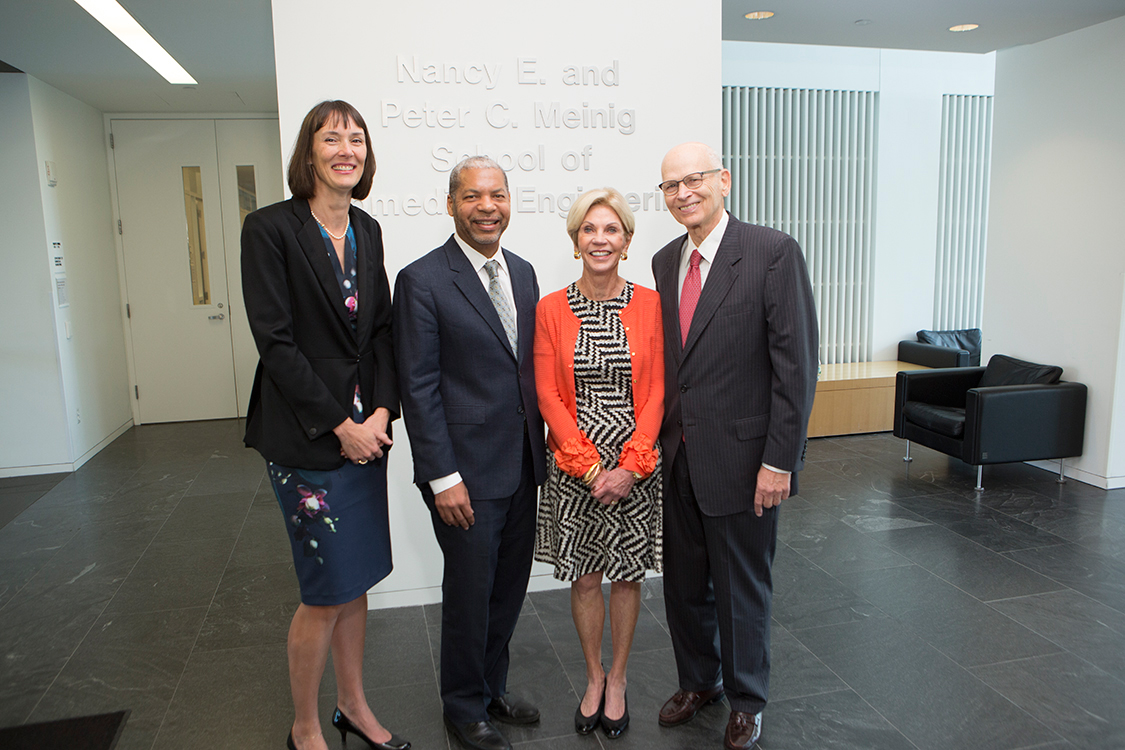Biomed engineering symposium honors Meinig family
By Krishna Ramanujan

When studying how young songbirds learn songs, a researcher employs neurobiology and audio tools to uncover reward mechanisms in the human brain that allow babies to learn basic skills – fundamental information that also informs causes and treatments of some developmental diseases.
Another researcher uses engineering strategies to discover how obesity makes fat tissue stiffer, thereby creating conditions that promote tumor growth. And a third scientist uses hydrogels to mimic stiffness in blood vessel walls to understand how atherosclerosis develops from cholesterol.
These are a few examples of cutting-edge research described at a biomedical engineering symposium, “Understanding and Treating Disease: Inspirations from Womb to Tomb,” on campus Sept. 16.
The symposium honored Nancy E. Meinig ’62 and Peter C. Meinig ’61, and their daughters Anne ’87, Kathryn, MBA ’93, and Sally – as well as their families – who made a $50 million gift earlier this year to expand the Department of Biomedical Engineering into the Nancy E. and Peter C. Meinig School of Biomedical Engineering. This fall the school began accepting sophomores into the new biomedical engineering undergraduate major.
“We are celebrating biomedical engineering and at the same time we want to very much thank the Meinig family,” said Marjolein van der Meulen, director of the Meinig School. “They have given a truly transformational gift to biomedical engineering.”
The symposium offered a snapshot of the impact biomedical engineering (BME) can have on understanding and treating disease and “provide a sense of the scope” of BME research at Cornell, which uses “multi-scale analysis to study human health and medicine,” van der Meulen said.
To display the range of related disciplines and the interdisciplinary nature of the field, symposium presentations were divided into three themes: “Revelations From Development and Genetics,” “Physical Science of Cancer” and “Aging and the End of Homeostasis.”
The themes gave glimpses into research addressing afflictions that occur at all life stages. For each theme, a presentation was made by a BME faculty member, a faculty member in another discipline (neurobiology and behavior, materials science and engineering, and veterinary medicine), and by a current or former graduate student.
Claudia Fischbach-Teschl, associate professor of biomedical engineering, who described her work on connections between obesity, breast tissue stiffness and cancer, commented on the necessity of interdisciplinary collaborations in biomedical engineering research.
“We as biomedical engineers or engineers in general need the biologists, and we need the clinicians. They are key to informing our strategies, and they are key to helping us fight the fight against cancer. Together I think we are a much stronger team,” she said.
Her work includes collaborations within the Meinig School, across the Ithaca campus and with researchers and clinicians at Weill Cornell Medical College, she said.
Michael Shuler, former chair and current professor at the Meinig School, provided a historical perspective of biomedical engineering at the university, which “existed at Cornell for many, many years, but not as an organized effort,” until a formal program was started in 1994 and a department was founded in 2004, with the intention of providing “a bridge between the medical school, the vet school, biology and physical engineering sciences,” he said.
Media Contact
Get Cornell news delivered right to your inbox.
Subscribe